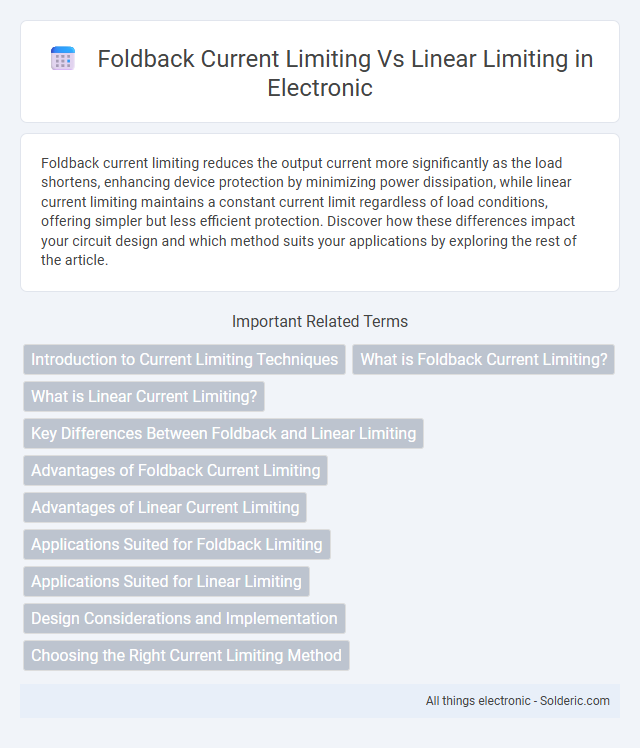Foldback current limiting reduces the output current more significantly as the load shortens, enhancing device protection by minimizing power dissipation, while linear current limiting maintains a constant current limit regardless of load conditions, offering simpler but less efficient protection. Discover how these differences impact your circuit design and which method suits your applications by exploring the rest of the article.
Comparison Table
| Feature | Foldback Current Limiting | Linear Current Limiting |
|---|---|---|
| Operation Principle | Reduces current drastically when overload occurs | Maintains a constant current limit regardless of overload |
| Current Reduction | Current drops as load increases beyond limit | Current fixed at preset limit |
| Efficiency | Improves safety by preventing excessive power dissipation | Higher heat generation due to fixed current limit |
| Applications | Power supplies, battery chargers | Precision current regulation, sensitive electronics |
| Complexity | More complex control circuit | Simple circuit design |
| Thermal Stress | Lower thermal stress on components | Higher thermal stress due to sustained current |
Introduction to Current Limiting Techniques
Foldback current limiting reduces output current progressively as the load exceeds a threshold, minimizing power dissipation and thermal stress in power supplies. Linear current limiting maintains a constant current level once the set limit is reached, providing steady protection but with higher power dissipation. Both techniques safeguard circuits by preventing excessive current flow, with foldback offering enhanced efficiency in overload and short-circuit conditions.
What is Foldback Current Limiting?
Foldback current limiting is a protection technique used in power supplies where the output current is reduced significantly once a certain threshold is exceeded, preventing excessive power dissipation and overheating. Unlike linear current limiting, which maintains a constant current limit beyond the threshold, foldback limiting decreases the current as the load short or fault condition worsens, enhancing device safety and efficiency during fault conditions. This method is commonly implemented in linear regulators and power management circuits to safeguard against sustained overloads or short circuits.
What is Linear Current Limiting?
Linear current limiting regulates output current by continuously controlling the pass element to maintain a fixed current level, preventing damage from overloads or short circuits. Unlike foldback current limiting, which reduces current drastically once a threshold is exceeded, linear current limiting provides a stable and constant current output during fault conditions. This method ensures predictable thermal performance and simplifies circuit design in power supplies and voltage regulators.
Key Differences Between Foldback and Linear Limiting
Foldback current limiting reduces the output current significantly once the current exceeds a set threshold, protecting the circuit by minimizing power dissipation and preventing thermal damage. Linear limiting maintains the current at a constant level without drastic reductions, ensuring more stable operation but potentially causing higher power loss and heat generation. Your choice between foldback and linear limiting depends on the balance between protection requirements and system stability in your electronic design.
Advantages of Foldback Current Limiting
Foldback current limiting significantly reduces power dissipation by lowering the output current as the load increases beyond a set threshold, enhancing thermal management and protecting both the power supply and connected devices more effectively than linear limiting. This method minimizes stress on components during short circuits or overload conditions, thereby extending the lifespan of your electronic systems. It also improves overall energy efficiency by preventing excessive current flow under fault conditions, which is crucial for sensitive applications and reducing operational costs.
Advantages of Linear Current Limiting
Linear current limiting provides precise and stable control over current flow, minimizing power dissipation and thermal stress on components compared to foldback current limiting. It maintains a constant current level without reducing output voltage drastically, ensuring reliable performance in sensitive electronic circuits. Your device benefits from improved protection and consistent operation with linear current limiting.
Applications Suited for Foldback Limiting
Foldback current limiting is ideal for applications requiring enhanced protection against short circuits and overcurrent conditions, such as power supplies, battery chargers, and motor controllers. This method reduces current significantly after the initial fault, minimizing heat dissipation and preventing damage to sensitive components in your circuit. In contrast to linear limiting, foldback limiting better manages severe faults by dropping the current to a safer level, ensuring device longevity and reliability.
Applications Suited for Linear Limiting
Linear current limiting is ideal for sensitive electronic devices requiring smooth and stable current flow during transient conditions, such as precision amplifiers and communication equipment. Its ability to maintain a constant current without abrupt cutoffs makes it suitable for testing circuits and protecting LEDs or semiconductors from damage. This technique is often preferred in applications demanding minimal noise and precise current regulation to ensure component longevity and reliability.
Design Considerations and Implementation
Foldback current limiting reduces output current significantly as load current increases beyond a threshold, improving thermal protection and preventing excessive power dissipation in power supplies. Linear current limiting maintains a constant current limit, simplifying design but often leading to higher power dissipation and thermal stress in components. Designers must balance efficiency, thermal management, and response speed when choosing between foldback and linear current limiting techniques for specific applications.
Choosing the Right Current Limiting Method
Foldback current limiting reduces output current drastically when a fault occurs, enhancing protection by minimizing power dissipation and preventing thermal stress in power supplies. Linear current limiting maintains a constant maximum current regardless of voltage drop, offering simpler implementation and stable performance in applications where continuous current flow is critical. Selecting between foldback and linear current limiting depends on the specific load requirements, thermal management constraints, and the necessity for power supply durability during short circuits or overload conditions.
Foldback current limiting vs Linear limiting Infographic

 solderic.com
solderic.com